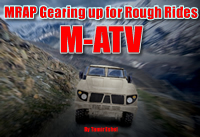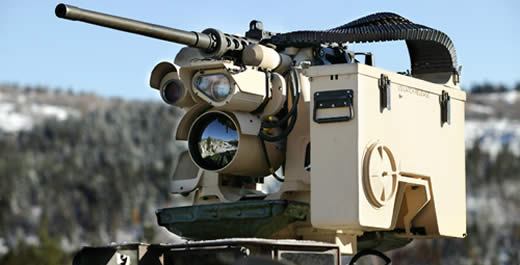Besides improving off-road mobility and maneuverability, M-ATV will implement lessons learned from the initial operations with MRAP vehicles in theater. For example, the new all-terrain version is required to be much quieter; the objective goal calls for interior noise level at each seating position to permit eight hours of continuous exposure without hearing protection. Another requirement, clearly specified, is negotiating water obstacles. Another lesson is the need for side lights, for night time route clearing and patrol. M-ATV will be provided with side-light illumination for visibility to the side of the vehicle up to 100 meters during night operations. Another aspect addressed in the requirement is fording performance. While the vehicle will not have amphibious capabilities, it is required to ford hard bottom fresh water to depths of up to 1.5 meters (60 inches) without special preparation or kits.
Mobility sustainment after combat damage is also a major concern. The vehicle shall be capable of traveling at least one kilometer after suffering a single 7.62mm perforation in the engine oil system, or coolant system, or fuel storage system. It will also be equipped with run flat tires, to sustain mobility up to 30-50 miles, traveling at a speed of 30 mph, after suffering multiple hits at two tires.
The vehicle will come with attachments and ‘A kits’ assemblies enabling ‘plug in’ of government furnished mission equipment (GEF). The vehicles are provided with an impressive set of systems. Standard gear will include navigation (DAGR), communications (SINCGARS), intercom, command and control (FBCB2) and displays, driver’s vision enhancer (DVE), and two rear view ‘Check six’ cameras. Standard protection equipment will include overhead wire mitigation systems, IED jammers. Route clearing vehicles will also carry Counter IED gear such as Rhino, and SPARKS.

The Rhino, which protrudes like a giant horn, is an electrical device mounted on the front of the vehicle and is designed to detonate roadside bombs along a route before the convoy reaches them. Specialized vehicles, such as the counter sniper vehicle configuration will also include the Boomerang sniper detection system and remotely operated weapon station (CROWS II). To sustain all these systems M-ATV will be equipped with power generation sustain 500 amperes capacity. The vehicles will be provided with a unit-level Battle Damage Repair Parts (BDR) package per supporting up to 25 repairing IED and other battle damages incurred by M-ATVs.
- M-ATV Specifications and Performance
- Implementing Lessons from the MRAP
- M-ATV Candidates
- Producing the M-ATV
- BAE Unveils Two M-ATV Models
- Cheetah M-ATV Candidate
- Oshkosh Unveils MTVR-Based M-ATV
- Navistar’s proposes MXT for M-ATV




















